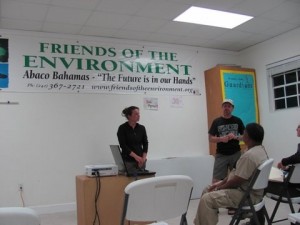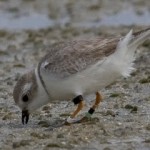It’s Better in the Bahamas – Part 2
Piping Plovers and Conservation Partners in the Tropics
By Todd Pover, Beach Nesting Bird Project Manager

We found the first piping plover nest of the season in New Jersey this week. In the course of our nest searching we also spotted two piping plovers marked with color bands indicating they had been banded in the Bahamas last winter. It is hard to believe that just a month ago these small birds were still settled in for the winter more than 1000 miles from our state.
And as I reported in an earlier installment of this series (It’s Better in the Bahamas – Part 1), I also spent a week in the Bahamas in January/February searching for piping plovers as part of the winter segment of the International Piping Plover Census. As exciting as it was to be part of the survey team scouring the islands and cays of the Bahamas looking for plovers, the Abaco (island) portion of the survey, which I participated in, was just as much about building conservation partners as it was about the survey work itself.
The Bahamas portion of the winter census was sponsored by the U.S. Geological Survey, in close collaboration with the Bahamas National Trust and the National Audubon Society, itself a great partnership. My participation came about because of a partnership I have been cultivating with Massachusetts Audubon Society’s Coastal Waterbird Program. They were already slated to assist with the Bahamas survey and suggested I come along as well.
Even before we boarded a plane to head to the Bahamas, numerous local contacts had been established. Nobody on the Abaco survey team had ever been to the Bahamas and there were dozens of islands and miles of shoreline to be searched. We were headed there to help because of our expertise about piping plovers, not local geography – so in the end the success of the project really hinged on local knowledge and participation to help direct our efforts.
And there was local assistance from the moment we arrived. I was met at the airport by
David Knowles, Chief Park Warden for the Bahamas National Trust on Abaco, who generously took time from his busy schedule to orient me around the island. Within minutes of piling into his car, we were discussing similar problems we faced dealing with cats striking ground nesting birds – in my case with beach nesting birds and in his case with the Bahama Parrot, whose stronghold is the southern part of Abaco. David was a critical link in establishing key contacts on the island and helping us gain assess to some sites that would have otherwise been off-limits.
Important support came from the Friends of the Environment, a conservation group dedicated to protecting Abaco’s marine and terrestrial environment. They hosted a public information session at their headquarters which allowed our research team to discuss the survey and raise awareness, but also garner feedback from locals as to where our efforts might be focused.
Important advice came from plenty of individuals as well. Woody Bracey, a well-known bird expert from Treasure Cay, shared much needed information prior to and during the census, provided logistical support when it came to housing and transportation, and participated in various segments of the survey. (He was also a great boat captain and brought us to an awesome sand flat on Green Turtle Cay – one of the highlights of our trip). Bruce Wolck provided similar birding expertise and support on Elbow Cay. Beyond that, these folks invited us into their homes to share stories – they were all around great “hosts”.
We were introduced to Loggerhead Productions, a local film production company, who tagged along to shoot footage of plovers and interview us. They are now interested in coming to the states to film piping plovers on their breeding grounds – this connection may lead to a compelling film about plovers sometime down the road.
We met and talked to bonefisherman and boat captains, sometimes hiring them on the spot to transport us out to hard to reach locations (there was no shortage of those). We coordinated with resort managers and even picked the brains of random folks lying under a palm tree if that’s what it took. It truly took a “village” to complete the surveys.
I have talked extensively in the past about developing conservation partnerships – to the extent I fear it is starting to sound like a “soapbox” – but it really is the model we need to follow, especially for migratory species, such as piping plover, that cross state and international borders.
Being so vested in piping plovers that nest in New Jersey, I can get a little possessive about “my” birds. The trip to the Bahamas was a good reminder that they actually spend the majority of the year elsewhere – if anything, the plovers I saw in the Bahamas are “their” birds. That was one of the messages we tried to leave with the groups and individuals we met along the way in the Bahamas. But I guess the real message should be that they are “our” birds. Ultimately, if we are going to be successful in recovering piping plovers, we all have an important conservation role to play, right here in New Jersey and a thousand miles away in the Bahamas.

